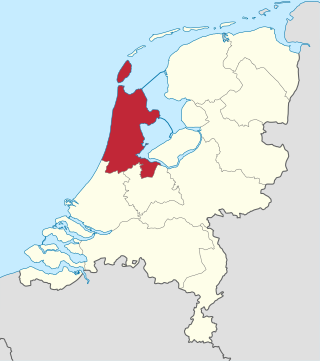
North Holland is a province of the Netherlands in the northwestern part of the country. It is located on the North Sea, north of South Holland and Utrecht, and west of Friesland and Flevoland. In November 2019, it had a population of 2,877,909 and a total area of 4,092 km2 (1,580 sq mi), of which 1,430 km2 (550 sq mi) is water.

Breukelen is a town and former municipality in the Netherlands, in the province of Utrecht. It is situated to the northwest of Utrecht, along the river Vecht and close to the lakes of the Loosdrechtse Plassen, an area of natural and tourist interest. It is located in an area called the Vechtstreek. It is the namesake of the borough of Brooklyn in New York City, United States.
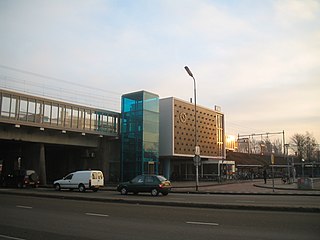
Heemstede is a town and a municipality in the Netherlands, in the province of North Holland. It is the fourth richest municipality of the Netherlands.

Floris V reigned as Count of Holland and Zeeland from 1256 until 1296. His life was documented in detail in the Rijmkroniek by Melis Stoke, his chronicler. He is credited with a mostly peaceful reign, modernizing administration, policies beneficial to trade, generally acting in the interests of his peasants at the expense of nobility, and reclaiming land from the sea. His dramatic murder, engineered by King Edward I of England and Guy, Count of Flanders, made him a hero in Holland.

A manor house was historically the main residence of the lord of the manor. The house formed the administrative centre of a manor in the European feudal system; within its great hall were usually held the lord's manorial courts, communal meals with manorial tenants and great banquets. The term is today loosely applied to various English country houses, mostly at the smaller end of the spectrum, sometimes dating from the Late Middle Ages, which currently or formerly house the landed gentry.

The Vecht is a Rhine branch in the Dutch province of Utrecht. It is sometimes called Utrechtse Vecht to avoid confusion with its Overijssel counterpart. The area along the river is called the Vechtstreek.
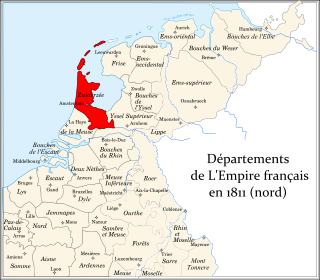
Zuyderzée was a department of the First French Empire in the present-day Netherlands. It is named after the Zuiderzee sea inlet. It was formed in 1810, when the Kingdom of Holland was annexed by France. Its territory corresponded more or less with the present-day Dutch provinces of North Holland and Utrecht. Its capital was Amsterdam.

Muiden Castle is a castle in the Netherlands, located at the mouth of the Vecht river, some 15 kilometers southeast of Amsterdam, in Muiden, where it flows into what used to be the Zuiderzee. It is one of the better known castles in the Netherlands and featured in many television shows set in the Middle Ages.

Kennemerland is a coastal region in the northwestern Netherlands, in the province of North Holland. It includes the sand dunes north of the North Sea Canal, as well as the dunes of Zuid-Kennemerland National Park.
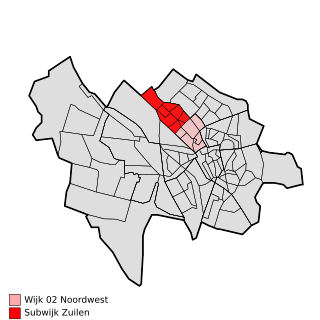
Zuilen is a district in the Northwest section of the Dutch city of Utrecht.
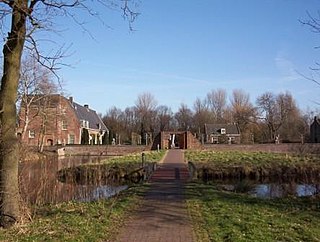
Heemstede Castle is the site of the old castle of Heemstede. The property is situated at the site of the former castle 'Heerlijkheid Heemstede', or 'Huis te Heemstede', at a strategic position on mouth of the Spaarne river on the Haarlem lake.

Gijsbrecht IV of Amstel or Gijsbrecht IV van Amstel was a powerful lord in the medieval County of Holland and a member of the Van Aemstel family. His territory was Amstelland, and his son was Jan I of Amstel.

Amsterdam, capital of the Netherlands, has more than 100 kilometers (62 mi) of grachten (canals), about 90 islands and 1,500 bridges. The three main canals, dug in the 17th century during the Dutch Golden Age, form concentric belts around the city, known as the Grachtengordel. Alongside the main canals are 1550 monumental buildings. The 17th-century canal ring area, including the Prinsengracht, Keizersgracht, Herengracht and Jordaan, were listed as UNESCO World Heritage Site in 2010, contributing to Amsterdam's fame as the "Venice of the North".

John Hope, also known as Jan Hope, was a wealthy Dutch banker, participating in Hope & Co., a member of the city council and an art collector. In 1770 he was appointed as manager of the Dutch East India Company (VOC). He is also known today for his Groenendaal Park in Heemstede, where he summered on his estate. Shortly before he died he bought the nearby "Bosbeek". This estate became one of the first examples of a large garden in the 'English Style' in the Netherlands, and shaped by his second son Adrian Elias. His oldest son Thomas Hope became a designer of neoclassical interior decoration, and his youngest son Henry Philip Hope a gem collector and jewelry specialist.
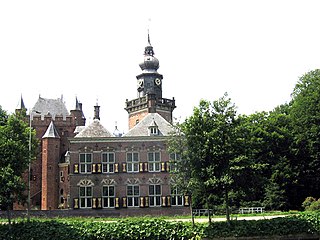
The Vechtstreek is a region in the Dutch provinces of Utrecht and North Holland along the Vecht River between the towns of Utrecht and Amsterdam. Located in the economic heartland of the Netherlands, it is known for its natural environment and history. The Vechtstreek is known for its many vestiges of the Dutch Golden Age, including castles, homes, parks and tea houses. They bear witness to the greatness and wealth of that period, the important commercial role played by the Vecht River and the area's history as a residential area for the nobility and wealthy.
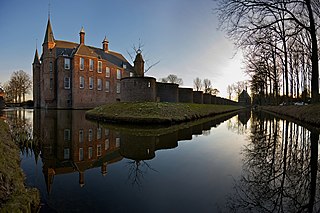
Zuylen Castle is a Dutch castle at the village of Oud-Zuilen just north of the city of Utrecht. It is located along the river Vecht at the southern end of the Vechtstreek.

Stichtse Vecht is a municipality of the Netherlands and lies in the northwestern part of the province of Utrecht.

Haerlempjes refer to a specific genre of landscape painting that includes a view of Haarlem. It is used most often to refer to Jacob van Ruisdael's panoramic views of the city, but the term is derived from mentions in Haarlem archives as a type of painting included in household inventories. The diminutive suffix "pje" would denote a small, cabinet-sized painting, but even the largest landscapes may be referred to as Haerlempjes today.
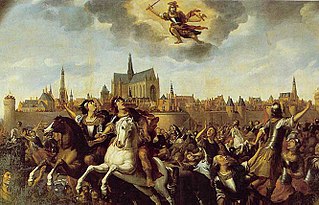
The Kennemer uprising was a rebellion of farmers in the County of Holland and Prince-Bishopric of Utrecht in the Holy Roman Empire, that took place between 1272 and 1274. The commoners or huislieden from the Kennemerland, a bailiwick within the County of Holland, rose up against their bailiff and the other nobles. The movement spread to the nearby West Friesland, Waterland and Amstelland. The lord of Amstelland, Gijsbrecht IV of Amstel decided to join the insurrenction and became the leader of the Kennemers. Later Utrecht, Amersfoort and Eemland also joined. Eventually, the Kennemers were defeated.

The Siege of Vredelant took place from late 1279 to 1280 and was fought between Floris V of Holland and Bishop-Elect John I of Nassau on one side and the rebellious Van Amstel family on the other side. The castle of Vredelant was taken within weeks when Gijsbrecht IV van Amstel was captured by the count's soldiers.
























